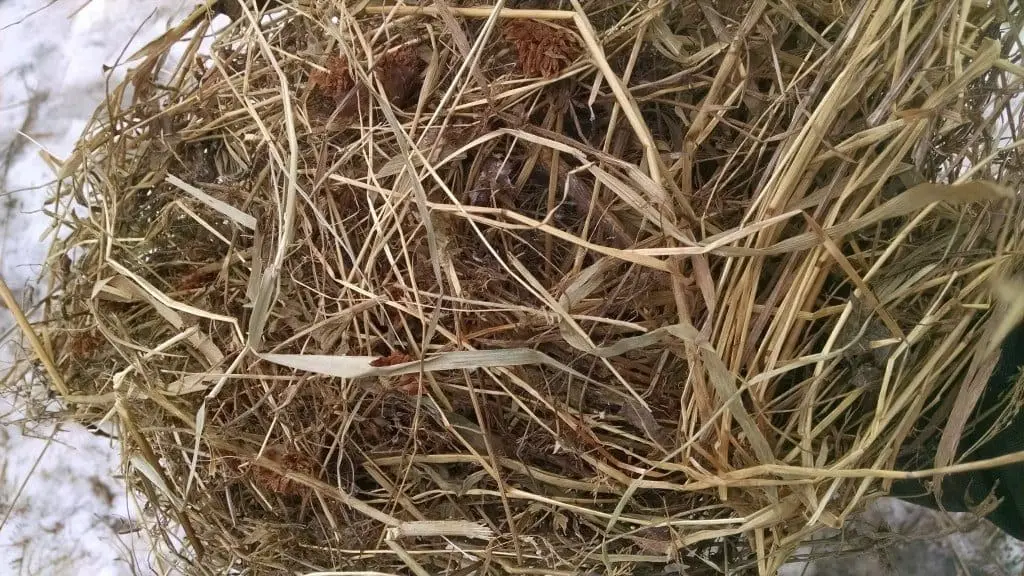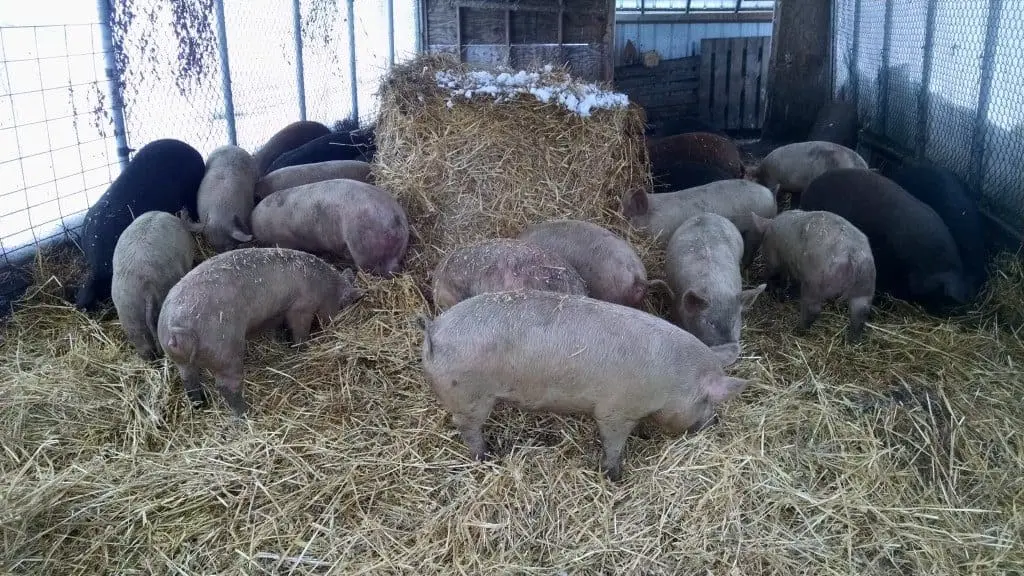The whole idea of feeding hay runs counter to the prevailing wisdom in swine production, where feeding anything other than supercharged grain rations is considered foolish. But in farms like ours where there are concerns beyond simple feed conversion calculations, hay feeding has its place. But I’ve always wondered: what is the right hay for pigs? We know from all the old books that pigs do quite well on alfalfa pastures. So a few years ago I bought some nice alfalfa/clover baleage and the pigs thought it was just OK. Given the choice between rank, stemmy hay bales and baleage, they always chose the hay when I placed them side by side. The cattle loved the baleage, vastly preferring it over even the best dry hay I had. So I know the baleage itself wasn’t at fault.
This year I’m feeding my pigs what would be considered junk bales by any standards. These bales have been sitting outside for two seasons. They were first cuttings from unfertilized hay fields cut in August 2015. They are full of weeds, stems, and thistles. The outside few inches are slimy but the cores are still in good shape. The pigs love them. I’ve been watching the pigs as they eat this hay, and it looks like they are searching through the hay. Their lips and tongues are agile, and their noses of course are keen sense organs, so I believe they are sorting the hay for the highest nutrition components. Sure, lots of the hay is nutritionally weak, but in any stand of rank grass there’s usually an understory of legumes and tender forage that still has lots of energy and protein. And I think that’s what they are going after. They seem (it is hard to tell because they shift around while eating) to be able to singulate down to individual leaves and stems to select the best ones while leaving the less valuable pieces on the ground. They need bedding on the ground anyway so the system seems to work automatically for me.

Since they need bedding anyway, I really don’t mind them doing the work to separate the bedding from the valuable hay. Sure, it isn’t a completely efficient process, but it leaves me thinking I should continue to feed pigs junk hay. Why not feed $15 round bales instead of $45? It saves me the hassle of worrying over them wasting good hay.
That’s my strategy for now. I’m not absolutely convinced it is the best way to go. Perhaps feeding high quality bales and providing separate bedding bales might pencil out differently, but these sorts of things are hard to measure empirically.


4 thoughts on “Finding the Right Hay for Pigs”
Hi Dave, this is Fatima of Duckduckbro from the Philippines.I remember your kind advise after our first traumatic farrowing and so we pushed on and have had a successful farrowing last June and two more last December. So I was curious, how do you decide when to cull a sow as far as farrowing and litter keeping is concerned? We have a sow, her second parity, crush 4 piglets in a litter of 11. I am thinking of not pushing through with a third farrowing.
How many live piglets do you average per litter? I understand you have pasture pigs. Our pigs are kept in pens in soil environment and the pens are 12 feet x 20 feet per pig, so there’s reasonable space … I hope.
As for hay (which we don’t have here), what our pigs love are dry coconut leaves. I also notice the pigs drink more after eating the leaves, which is great for sows especially during the hot and dry season.
Happy New Year! 🙂
Hi Fatima,
Glad to hear about your recent successes.
Regarding the decision to cull, it is always tough to be strict but I’ve learned the hard way that a sow that starts doing a bad job on her litters usually doesn’t turn around and start doing better in the future. I’m not sure what it is but I have had some sows do a spectacular job caring for large litters at the beginning and then really mess up the second time and they have consistently failed to demonstrate good mothering skills afterwards. So culling is probably advisable. If you have a means of maintaining a sow for very low cost, then you might be able to be less strict in culling. If you are buying all her feed then it probably doesn’t make sense to keep her.
Regarding litter size, I think good pigs should be able to consistently give you ten pigs. This is an area where I’ll admit to doing a poor job of culling and I’ve allowed far too many 4-6 pig litters slip past me. I’m actually working on a plan to stop breeding pigs for a while and to buy all my piglets from a few local farms, but that’s a story for another day…
Lastly, regarding the coconut leaves, I really like the idea of getting lots of fiber into a pig’s diet, especially as they get bigger and have more digestive tract capacity to metabolize fiber via hindgut fermentation. Interestingly I read some farming magazine articles a while back where sows were only fed grain every-other day. Spacing out the feedings saved the farmer time and it encouraged the sows to eat more hay. The pigs seemed to do just fine with this staggered feeding approach. So yes, lots of coarse plant material is good as this provides a diet more consistent with the sorts of things wild pigs would be eating.
I’ve fed a number of different dairy quality baleages to my pigs. So far my limited observation is that they like wetter bales more than drier bales. This year for example, I’ve fed three different grass/legume mixes. One was dryish still green grass/clover, one was wetter more fermented (dark) grass/clover, and one was wet but still greenish grass/alfalfa. Their least favorite by far was the drier stuff, then probably the fully fermented, and the favorite is that middle ground of fermentation – soft, partly digested, but still green enough to maybe have more energy in it?
In the old hay bales did you have much milkweed? My pigs don’t particularly like it fresh, but they’ll pull a whole bale apart looking for those leaves after it’s fermented (don’t know about dry hay milkweed).
I also am on the fence about how best to quantify hay feed value and whether paying for the good stuff is worth it for pigs if they get to dismantle the bales. This year we’ve got the good quality baleage out of the pig hoop on its own to try to prevent it being used as bedding, but they still pull it apart and trod the hay into the ground. Maybe with a TMR mixer I could come close to eliminating hay waste, but barring that, I don’t know what to do to really tamp down on the wastage.
From a flavor perspective and animal health perspective I think having forage in front of the pigs at all times is really important. I just don’t know if the cost of dairy quality hay is worth the premium over lower quality stuff that the pigs still eat.
Flavor, animal health, and don’t forget to add the smell of the manure to the list! All are improved by hay feeding.
One way to put this into perspective is that I rarely graze pigs on dairy-quality pasture in the summer either. They might not get as much feed value from weeds and brush as they would on lush alfalfa, but they thrive on pretty scrubby land with proper supplementation. Since a purely forage-raised pig has’t proved feasible in my circumstances, some degree of supplementation (whey, grain, or both) is going to be an ongoing reality. And since I am dealing with a small land base and a very small amount of tillable acres where I could plant things like alfalfa, the economics work out far better to devote my best forages to my beef finishers. I think that logic applies to the pigs in winter too, where premium hay gives me the best return on investment when it goes through a steer rather than a pig. Again, this involves some amount of conjecture since it is so hard to measure how much of the hay goes into the pig versus the amount that gets used for bedding.
Lastly, on the milkweed. The low quality bales are all sure to contain milkweed, thistles, burdock, multiflora rose, knapweed, teasel, bindweed, wild parsnip, and I’m sure another dozen “weeds” that I can’t remember right now. But I haven’t been able to really tell what the pigs are eating because they tend to eat in an exuberant jumble of pushing, shoving, climbing, and running. They never settle down to eat a bale in a methodical, workmanlike way as you’d see with a group of cows.